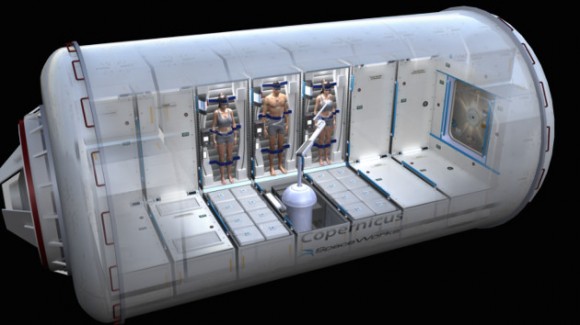Manned missions to deep space present numerous challenges. In
addition to the sheer amount of food, water and air necessary to keep a
crew alive for months (or years) at a time, there’s also the question of
keeping them busy for the entirety of a long-duration flight
Exercise
is certainly an option, but the necessary equipment will take up space
and be a drain on power.
In addition, they’ll need room to move around, places to sleep, eat,
work, and relax during their down time. Otherwise, they will be at risk
of succumbing to feelings of claustrophobia, anxiety, insomnia, and
depression – among other things.
NASA has been looking at a few options and one proposed solution is
to put these crews into an induced state of hypothermia resulting in
torpor – a kind of hibernation. Rather than being awake for months or
years on end, astronauts could enter a state of deep sleep at the
beginning of their mission and then wake up near the end. This way, they
would arrive refreshed and ready to work, rather than haggard and maybe
even insane.
If this is starting to sound familiar, it’s probably because the
concept has been explored extensively by science fiction. Though it goes
by different names – cryosleep, reefersleep, cryostasis, etc. – the
notion of space explorers preserving their bodies through cryogenic
suspension has been touched upon by numerous sci-fi authors, movies and
franchises.
But NASA’s plan is a little different than what you might remember from 2001: A Space Odyssey or Aliens.
Instead of astronauts stepping into a tube and having their temperature
lowered, torpor would be induced via the RhinoChill – a device that
uses invasive tubes to shoot cooling liquid up the nose and into the
base of the brain.
To research the technology, NASA has teamed up with SpaceWorks,
an Atlanta-based aerospace company that is investigating procedures for
putting space crews into hibernation. During this year’s International
Astronomical Congress – which took place from Sept. 29th to Oct. 3rd in
Toronto – representatives from SpaceWorks shared their vision.
According to the company, inducing torpor in a crew of astronauts
would eliminate the need for accommodations like galleys, exercise
equipment, and large living quarters. Instead, robots could electrically
stimulate key muscle groups and intravenously deliver sustenance to
ensure the health and well being of the astronauts while in transit.
As Dr. Bradford, President of SpaceWorks Enterprises Inc., told Universe Today via email:
“We have completed the initial evaluation of our concept which
demonstrated significant benefits against non-torpor Mars mission
approaches and established the medical plausibility of torpor. We have
expanded our team and put together a development plan that we are in the
process of executing. While the longer term goal of enabling access to
Mars is our ultimate objective, we have a number of near-term,
commercial applications for this technology that we will develop along
the way.”
In addition to cutting down on the need for room and supplies,
keeping crews in hibernation would also save on another all-important
factor: costs. With a crew in stasis, ships could be built smaller or
have more room to accommodate safety features like radiation shields. At
the same time, smaller, lighter ships would mean that material,
construction, and fuel costs would be lower.
According to SpaceWorks’ mockups, the size of a crew living quarters
for a Mars mission could be reduced from the currently-proposed
dimensions of 8.2×9 meters to just 4.3×7.5. Also, current projections
indicate that a Mars ready-habitat for a 4-person crew would weight
roughly 31 tons. But the company claims that a torpor-stasis habitat
could weigh as little as 15.
Of course, SpaceWorks also emphasized the psychological benefits.
Rather than being awake for the entire 180 day journey, the crew would
be able to go to sleep and wake up upon arrival. This would ensure that
no one succumbs to “space madness” during the months-long journey and
does something terrible – like take their own life or those of the crew!
Naturally, there is still plenty of research and development that
needs to be done before a torpor hibernation system can be considered a
feasible option for space travel. RhinoChill has so far only been used
in therapeutic scenarios here on Earth. The next step will be to test it
in orbit.
Luckily, the potential savings during a trip to Mars or somewhere in
the outer Solar System could be just the incentive to make it happen.
And no matter what, it seems that some form of induced-hibernation will
be necessary if ever humanity is ever to explore the depths of space.
“We are at the dawn of a new era in space and my company is excited
to be working at the forefront,” Bradford said. “I believe our
technology will be required to support human missions to Mars. It offers
an affordable solution by leveraging ongoing medical research to
address challenges spanning engineering, human health, and psychology
for which we do not have alternate solutions. This can be ready for the
first Mars mission and we are talking with partners to make this
happen.”
Further reading: SpaceWorks Enterprises


No comments:
Post a Comment
Note: Only a member of this blog may post a comment.